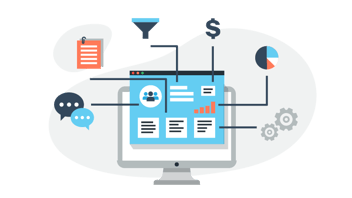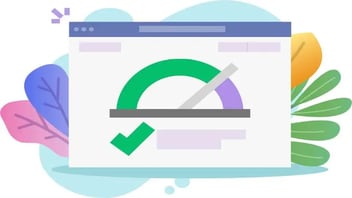7 modi per migliorare il tasso di conversione nel 2026
In che misura i vostri attuali sforzi di marketing stanno dando benefici alle conversioni? Il tasso di conversione è uno dei parametri principali che molte aziende utilizzano per determinare il successo dei loro sforzi di marketing online. Tuttavia, non tutte le aziende riescono a ottenere un buon tasso di conversione. Se avete difficoltà a ottenere conversioni, scoprite sette modi per migliorare il vostro tasso di conversione.


Qual è il tasso di conversione?
Il tasso di conversione si riferisce alla percentuale di utenti che hanno completato un'azione specifica sul vostro sito, come l'invio di un modulo o un acquisto. È possibile calcolare il tasso di conversione utilizzando questa semplice formula:
Tasso di conversione = (Numero di conversioni ÷ visitatori totali) x 100.
Ad esempio: (80 ÷ 2.500) x 100 = 3,2%.
Perché un alto tasso di conversione è importante?
Il tasso di conversione gioca un ruolo fondamentale nel determinare il successo di una campagna di marketing digitale. Essendo un dato cruciale per i proprietari di aziende, conoscere il tasso di conversione consente di ottimizzare gli sforzi e massimizzare il ritorno sugli investimenti (ROI).
Altri motivi per cui è essenziale migliorare il tasso di conversione sono:
-
Determinare il successo di una campagna o di una strategia digitale.
-
Permette di identificare gli utenti di valore per ottimizzare l'imbuto di conversione.
-
Può aiutare a identificare le aree di miglioramento nell'imbuto di vendita.
-
Prendere decisioni informate sulle vostre campagne di marketing.
Ma cosa si intende per buon tasso di conversione? Questo varia a seconda della vostra attività e del vostro settore. In generale, secondo Mailchimp, un tasso compreso tra il 2% e il 5% è considerato un buon tasso in tutti i settori.
Tuttavia, questo dipende anche dal numero di visitatori del vostro sito. Un basso numero di conversioni da un alto numero di visitatori è spesso un segno che qualcosa non va nell'imbuto di conversione. È quindi necessario ottimizzare e migliorare il tasso di conversione.
Come migliorare il tasso di conversione
Se scoprite che il vostro tasso di conversione è basso e deve essere migliorato, ci sono molti modi per farlo. Vediamo come migliorare il vostro tasso di conversione nel 2024:
1. Raccogliere e analizzare i dati
Il primo passo per migliorare il vostro tasso di conversione è raccogliere e analizzare i dati. Ottenere informazioni utili e informative dai dati è un modo sicuro per ottenere risultati. Il primo punto di partenza per la raccolta e l'analisi dei dati è l'analisi del vostro sito web.
Piattaforme come Google Analytics possono fornirvi una grande quantità di dati rilevanti da analizzare, tra cui il traffico, le fonti di traffico, le percentuali di clic e altro ancora. Assicuratevi di analizzare i dati per ogni pagina e di esplorare i canali di traffico per ottenere la massima comprensione.
L'altro metodo per raccogliere dati significativi è il contatto con i clienti. La raccolta di dati qualitativi dai vostri clienti su come hanno affrontato il processo di acquisto può fornire alcuni dei migliori spunti su cui agire.
Prendete in considerazione domande come "Cosa vi ha convinto ad acquistare da noi?" o "C'è stato qualcosa che vi ha quasi impedito di acquistare da noi?".
2. Analizzare l'imbuto di conversione
Un altro modo per ottimizzare il tasso di conversione è analizzare l'imbuto di conversione. L'imbuto rappresenta i diversi punti del percorso del cliente ed è in genere suddiviso in quattro sezioni denominate AIDA: consapevolezza, interesse, desiderio e azione.
Ogni sezione dell'imbuto di conversione indica una fase diversa in cui il cliente si trova prima di agire e convertire. Gli imbuti di conversione di successo aiutano i clienti fornendo contenuti e comunicazioni pertinenti.
Analizzando il vostro imbuto di conversione, vi immergete nel viaggio che i clienti compiono quando acquistano da voi. In genere si tratta di esaminare le pagine più viste, il tempo trascorso su ciascuna pagina e le pagine con un alto tasso di uscita. Vale la pena di esaminare anche le pagine con un'elevata frequenza di rimbalzo.
3. Ottimizzare i contenuti
L'ottimizzazione dei contenuti è un altro metodo per migliorare il tasso di conversione. Può riferirsi alla qualità dei contenuti, al design della pagina di destinazione o alle call-to-action (CTA). Ognuno di essi svolge un ruolo cruciale nel guidare i clienti verso l'obiettivo finale della conversione.
Il testo scritto della pagina deve essere informativo e significativo, in modo da aiutare i clienti a percorrere il viaggio dell'acquirente. È inoltre importante comunicare la propria proposta di valore attraverso i contenuti web.
Contenuti chiari, ben strutturati e leggibili contribuiscono ad attrarre e coinvolgere gli utenti. È possibile fare un ulteriore passo avanti utilizzando contenuti personalizzati, che possono essere realizzati per specifici segmenti di clienti o individualmente.
Oltre al testo scritto, dovete anche assicurarvi che il design della vostra landing page e le CTA seguano le migliori pratiche di ottimizzazione del tasso di conversione. Eliminare il maggior numero possibile di distrazioni e seguire le migliori pratiche di call-to-action sono buoni metodi da seguire quando si ottimizzano le landing page.
Poi, l'implementazione di test A/B vi aiuterà a testare due variazioni nel design per vedere quale funziona meglio per guidare le conversioni. Può trattarsi di due diversi design di pagina, fino a una CTA diversa. Anche le heatmap possono essere utili per osservare come gli utenti interagiscono e si impegnano con una pagina.
4. Migliorare l'esperienza dell'utente
Migliorare l'esperienza dell'utente (UX) è un altro modo per migliorare il tasso di conversione. L'esperienza utente è la sensazione che un utente prova quando utilizza il vostro sito web. La pertinenza dei contenuti, la facilità d'uso e un buon web design sono tutti fattori che influiscono sull'esperienza dell'utente.
Un sito web non ottimizzato per l'esperienza dell'utente è molto più probabile che abbia un'alta frequenza di rimbalzo e di uscita. Di conseguenza, i tassi di conversione ne risentiranno. Fortunatamente, esistono alcuni modi per migliorare l'esperienza dell'utente e favorire le conversioni.
Il primo di questi è aggiungere una barra di ricerca o una funzionalità di ricerca al vostro sito. In questo modo gli utenti possono trovare rapidamente ciò che cercano, sia che si tratti di informazioni, di un prodotto o di una pagina. Ciò contribuisce a migliorare la navigazione e consente agli utenti di raggiungere rapidamente i propri obiettivi.
Anche la facilità di navigazione del sito e delle pagine è fondamentale per un'esperienza utente positiva. Una struttura chiara del sito e dei contenuti permette agli utenti di trovare le informazioni che cercano in modo semplice e veloce.
Anche la velocità della pagina gioca un ruolo importante nell'esperienza dell'utente. In genere, le pagine con una velocità di caricamento molto bassa registrano tassi di rimbalzo molto più elevati. I dati di Google affermano che un aumento del tempo di caricamento della pagina da 1 secondo a 3 aumenterà probabilmente la frequenza di rimbalzo del 32%.
5. Migliorare i moduli e i checkout
Un altro metodo che potete utilizzare per migliorare il vostro tasso di conversione è quello di migliorare i moduli e le casse. Rendere più semplice per gli utenti l'invio di un modulo o il completamento di un checkout è un ottimo modo per aumentare le conversioni.
Più tempo è necessario per compilare un modulo o completare il processo di checkout, più è probabile che il vostro tasso di conversione ne risenta. Per questo motivo è fondamentale assicurarsi di includere nei moduli solo i campi essenziali. Anche ridurre il numero di processi durante il checkout può essere utile.
Ci sono altri modi per migliorare l'invio dei moduli e del checkout. Il primo è l'implementazione di una funzione di chat. Con l'aumento dei chatbot negli ultimi anni, molti siti web hanno deciso di implementare un assistente di chat AI per aiutare i clienti durante la fase finale del percorso dell'acquirente.
È inoltre possibile iniziare a implementare lo shopping direttamente all'interno dei social media. Instagram Shopping o TikTok Shopping sono due esempi di piattaforme di social media che integrano la vendita di prodotti direttamente sulla loro piattaforma. Offrire la possibilità di acquistare direttamente sulla piattaforma in cui si trovano i vostri utenti è un ottimo modo per aumentare le conversioni.
L'altro metodo che potete utilizzare sono le e-mail di abbandono del carrello. Si tratta di e-mail automatiche che vengono inviate agli utenti se lasciano un articolo nel carrello per un certo periodo di tempo. Le ragioni per cui gli utenti abbandonano il processo di acquisto sono molteplici. L'invio dell'e-mail giusta può ricordare agli utenti e invogliarli a concludere l'acquisto. A volte, anche l'offerta di un incentivo può essere utile.
6. Considerare un programma di referral
L'implementazione di un programma di referral è un altro metodo che potete utilizzare per migliorare il vostro tasso di conversione. Potreste essere sorpresi di scoprire che i tassi di conversione dei clienti segnalati possono raggiungere il 30% (un bel salto rispetto al tasso di conversione medio del 3-5%).
Vale anche la pena di notare che le persone sono più propense a fare un acquisto quando questo viene consigliato da un amico o da un familiare. Ecco perché l'implementazione di un programma di referral può essere vantaggiosa. Un programma di referral di successo porterà benefici sia ai clienti esistenti che a quelli nuovi.
In questo modo, il vostro tasso di conversione aumenterà e potrete beneficiare di clienti più fedeli. I clienti più fedeli spendono probabilmente fino al 35% in più presso la vostra azienda rispetto a un concorrente. Inoltre, è probabile che abbiano un valore di vita più elevato.
7. Beneficiare della riprova sociale
Un altro metodo che potete utilizzare per migliorare il vostro tasso di conversione è l'implementazione della riprova sociale. La riprova sociale è un termine psicologico che afferma che le persone copiano le azioni o i comportamenti degli altri in determinate situazioni. In genere, ciò avviene quando qualcuno si trova in una situazione non familiare.
Lo stesso principio si applica anche per aumentare il vostro tasso di conversione. Implementare la prova sociale in prossimità dei luoghi in cui è probabile che un cliente agisca può aumentare il vostro tasso di conversione, tra cui:
- Nel carrello della spesa
- Nei post pertinenti del blog
- Incluso nei casi di studio
- Accanto o nei moduli di iscrizione
- Nella barra laterale del sito web
- Nelle pagine di prodotto o di destinazione
La riprova sociale può essere costituita da valutazioni a stelle e strisce, recensioni positive dei clienti, sponsorizzazioni di celebrità e pop-up che incutono timore. L'aggiunta di prove sociali a posizioni rilevanti è un modo sicuro per aumentare i tassi di conversione. Inoltre, contribuisce a creare fiducia nei clienti.
Trovare metodi per aumentare il tasso di conversione della vostra azienda è fondamentale per garantire il successo. Che si tratti di una nuova attività o di un'attività esistente che soffre di bassi tassi di conversione, dedicare del tempo all'analisi della situazione e all'implementazione delle tattiche pertinenti sopra descritte può mettervi sulla strada giusta per aumentare le conversioni, costruire la fiducia dei clienti e migliorare il vostro ROI.
Questo contenuto è disponibile in:
- Tedesco: 7 Wege zur Verbesserung Ihrer Konversionsrate im Jahr 2026
- Inglese: 7 Ways to Improve Your Conversion Rate in 2026
- Spagnolo: 7 maneras de mejorar su tasa de conversión en 2026
- Francese: 7 façons d'améliorer votre taux de conversion en 2026
- Rumeno: 7 moduri de a vă îmbunătăți rata de conversie în 2026
- Cinese: 2026 年提高转化率的 7 种方法








Facci sapere cosa ne pensi.